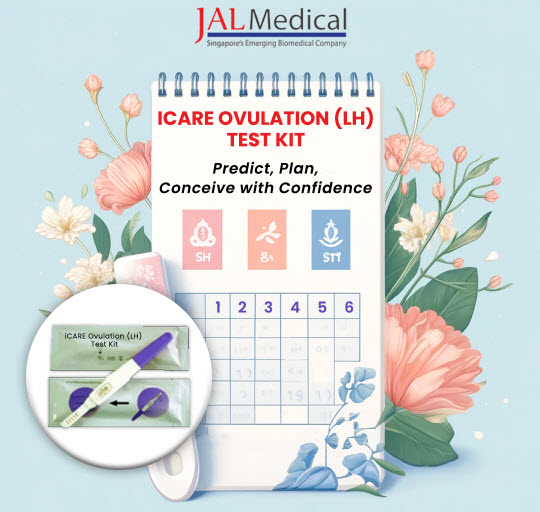Table of Contents
Tracking ovulation is a critical component of fertility planning and ovulation test kits have become reliable tools for predicting the most fertile days in a woman’s cycle. These kits work by detecting the luteinizing hormone (LH) surge that signals imminent ovulation. This article addresses the most frequently asked questions surrounding ovulation detection kits, covering functionality, usage, accuracy and influencing factors. Whether you’re trying to conceive or monitoring your reproductive health, understanding how these kits work is essential for making informed decisions.
What is an Ovulation Test Kit and What Does It Detect?
An Ovulation Test Kit is a rapid diagnostic device that helps identify the most fertile phase of a woman’s menstrual cycle. It works by detecting the Luteinizing Hormone (LH) surge in urine, which typically occurs 24 to 36 hours before ovulation. This hormone surge indicates the body is preparing to release a mature egg, making it the optimal time for conception. These test kits are often referred to as LH Test Kits. They are essential for women tracking ovulation either for conception or to better understand their hormonal cycle.
How Does an Ovulation Rapid Test Kit Work Mechanically?
The Ovulation Rapid Test Kit utilizes immunochromatographic technology to identify LH in urine. A sample is collected – either by direct urination onto a LH Midstream Test or by dipping ovulation strips into a urine specimen. The sample moves via capillary action through a membrane coated with anti-LH antibodies. If LH levels exceed the kit’s sensitivity threshold, the test area will display a colored line or digital symbol. A strong line or “positive” signal confirms an LH surge, indicating ovulation is imminent. This makes such kits highly effective in forecasting the fertile window.

When Should One Start Testing With a Test Ovulation Kit?
The timing of when to use a Test Ovulation Kit depends on individual cycle length. For a typical 28-day cycle, testing should begin on day 10 or 11. Women with longer cycles may start later, while those with shorter cycles may need to begin earlier. A helpful general guideline:
| Cycle Length | Start Testing On |
| 24 days | Day 7 |
| 28 days | Day 10 |
| 32 days | Day 14 |
| 35 days | Day 17 |
What Does a Positive Result from an Ovulation Test Indicate?
A positive result on an ovulation test means that an LH surge has been detected in the urine. Ovulation is likely to happen within 24 to 36 hours, marking the peak fertility period. In ovulation strips, a positive is usually shown by the test line being as dark or darker than the control line. In digital ovulation monitor kits, a symbol or alert will appear. This result signals the ideal time for intercourse or fertility treatment procedures to maximize the chances of conception.
Are Ovulation Prediction Kits Effective for Women With Irregular Cycles?
Yes, ovulation prediction kits can be used by women with irregular cycles, although detecting the LH surge may require extended testing. Women with cycle variability may start testing immediately after menstruation ends and continue for more days than average. The use of ovulation rapid test kits in such cases is often paired with other ovulation indicators, such as basal body temperature or cervical mucus tracking, to confirm fertile days. Despite the irregularity, LH levels still surge before ovulation, which these kits are designed to detect effectively.
How Accurate Are LH Test Kits in Predicting Fertility?
Most LH Test Kits offer a sensitivity range that enables detection of LH concentrations with high accuracy, provided they are used correctly. Factors that influence their accuracy include:
- Timing of sample collection
- Concentration of the urine sample
- Proper storage and use of the kit
However, a positive LH surge does not guarantee ovulation, especially in cases of Luteinized Unruptured Follicle Syndrome (LUFS), where the egg may not release despite the LH peak. Still, these tests remain a reliable method of identifying the ovulation phase in most users.
What Factors Can Interfere With Ovulation Test Kit Results?
Certain medications and health conditions may interfere with Ovulation Test Kit results. These include:
- Fertility medications (e.g., Clomiphene, hCG): Can cause false positives
- Hormonal contraceptives: Suppress LH and may result in false negatives
- Polycystic Ovary Syndrome (PCOS): Causes chronically high LH levels, complicating result interpretation
- Perimenopause: Leads to hormonal fluctuations that may mimic an LH surge
Users should consult if they are undergoing treatment or managing conditions that may affect hormone levels.
What Samples Are Required for Ovulation Testing?
The sample type used in ovulation testing is typically urine, collected either midstream or in a clean container. There are two main formats:
- LH Midstream Tests: Used directly in urine flow; highly convenient and hygienic
- Ovulation Strips: Dipped into a collected urine sample; often used in bulk for daily testing
For best results, it’s advised to test when LH levels are more concentrated. Avoid testing immediately after waking or consuming large volumes of fluid.
Is It Possible to Miss the LH Surge Despite Regular Testing?
Yes, some women may miss detecting their LH surge even with daily testing. This may occur if:
- The LH surge is very short-lived
- Testing is done too early or too late in the cycle
- Urine is too diluted to detect LH accurately
To avoid missing the surge, some users test twice daily during the expected fertile period. Using a high-sensitivity ovulation monitor kit may also increase the chance of capturing brief hormone changes.
Can Ovulation Test Kits Be Used for Birth Control Purposes?
No. Ovulation test kits are not approved or recommended for contraceptive use. While they help identify fertile windows, they do not prevent ovulation or pregnancy. Sperm can survive in the reproductive tract for up to five days, so intercourse before a detected LH surge can still result in conception. Individuals seeking reliable contraception should consult a medical professional for appropriate birth control methods.
Conclusion
Ovulation test kits are highly effective kits for tracking the fertile window in a woman’s cycle. By detecting the LH surge with high precision, they support individuals and couples in planning conception with improved timing. Their ease of use, rapid results and accessibility make them valuable for both at-home fertility tracking and clinical applications. However, one must understand the limitations and influencing factors to ensure correct interpretation of results. When used consistently and correctly, these diagnostic devices contribute significantly to reproductive awareness and fertility success.








